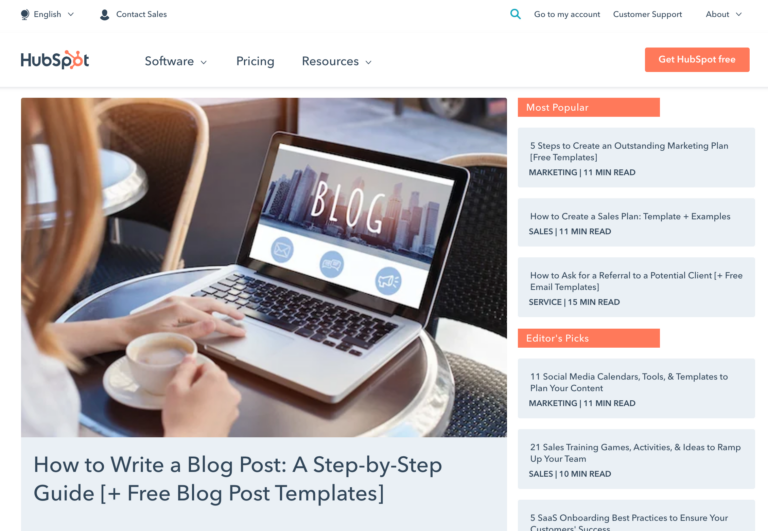Everyone hates the SEO format. But every channel has a “format”
Everyone seems to hate SEO content these days.
A lot of “what is” articles and listicles with your product listed as #1.
Guilty as charged.
I do both of those things.
But here’s the crazy thing – it generally still works.
Here’s an update on one of my most successful posts. It’s still chugging along after a year and a half, gaining new keywords all the time. Guess what? It’s a middle funnel list post.
Even though many marketers follow formats all the time. For Twitter or LinkedIn and even TikTok has its own format.
That split screen, talking to yourself thing? That’s a format.
Here are my takeaways from XYZ, a thread? That’s a format.
But when you’re specifically writing for SEO, remember this:
- What problem are you trying to solve? Sometimes you’re trying to educate, other times you’re trying to help people make an informed decision, you could be trying to show them step-by-step how to do something, or an in-depth review or comparison.
- Know the purpose and problem you’re trying to solve influences its format. Which part of the funnel is it addressing? That will determine your format. You may need a chart, a back-and-forth discussion, a video, a podcast, an anecdote or no anecdote.
- Start with a key foundation before enhancing. Your article could be enhanced by a whiz-bang click-thru game, but if that’s not what the SERP shows it’ll (probably) be a long road.
That doesn’t mean it’s bad. It just won’t do as well without the key foundation. That includes headers, keywords, and specific topics.
Frase (affiliate) and MarketMuse are 2 tools I use that are very good at this. If you have something to say outside of those, it’s not bad – you may just need another post.
- Then enhance. Once you have the foundation laid, add the extras and enhancements. More video content or graphics or that interactive game.
Google *is* a distribution channel, but here’s why people don’t like it
Let’s return to why people crap on SEO.
It’s not cool or sexy anymore. It was maybe in 2011, but not now.
You know what’s cool? Twitter threads! TikTok! LinkedIn live video. Or whatever.
And you know why organic search isn’t as cool? Because it takes a long time. And people hate waiting.
A lot of the most awesome Twitter threads will spike and then are lost to history a few days later.
That’s good in some ways because those creators can use them again, but overall, they don’t bring in repeatable traffic.
Same with your viral TikTok.
You have to pound away all the time for the momentum to keep going, until you reach a massive level then your back catalog becomes instantly more valuable.
Generally speaking, search has a lot of compound interest.
And it still does.
But no one likes that. You don’t get the fast dopamine hit.
People don’t like Google as a distribution channel because it takes time.
But we’re all notoriously addicted to the *now*
The slow burn that comes with search won’t cut it.
Even in the long run it will.
That’s harder to sell. And harder to believe.
Quite frankly, it’s more fun to go after the quick win and success story. It’s easier to measure. It’s easier to share. But it’s way harder to do.
When you need another distribution channel (and when you don’t)
I’m (almost) a one-trick pony.
I’ve found a way to crack organic search, to a certain extent. I’m not the best, I’m not the worst.
What’s funny is that wasn’t always the case. I’ve always been a writer, but I was a journalist, and then a copywriter, a catalog editor, and then I grew into a marketing manager type role.
The team I was on was responsible for list management, creative campaigns, events, email nurturing, all of it. I was the writer and created concepts, we had a design team, and then an ops team who would do a lot of the back-end management. It worked okay.
And guess what? SEO wasn’t even one of our channels.
The niche healthcare industry I was working in didn’t really call for it. I didn’t even get close to what I’m doing now until 2017.
I’m not against other distribution channels. In fact, I’vem mostly been in other channels my whole career.
But I was burned by a few things with the nebulous “other channels”
- A lot of coordination for very little payoff
- A lot of money for a tradeshow booth that the sales team mostly avoided
- Long, picked-over email campaigns that received few clicks
This is why I like content. It fits into a lot of different channels.
It can fit into social or a newsletter or you can even run ads to it.
I do suggest having 2 or 3 channels that you feel comfortable with.
It depends, of course, but don’t jump on TikTok just because. Instead, branch out to the next one that makes sense.
At Workzone, it was a heavy paid presence. SEM, review sites, and cold outreach. SEO and content picked up some of the slack, but they were hoping to fully transition off of paid, which they’ve never done. They would be a massive site now, but they gave up.
Content didn’t work together.
In the early days of ClickUp, we really didn’t do anything except organic search. We tried a few paid things, but we were very good at attentive listening on social. We looked for conversations around task and project management and jumped in there. We also had a good Quora presence. But the content helped with Twitter and especially Quora.
So the 3 channels (early, early days) were: SEO, responsive Twitter, and Quora.
The product also had an undeniable product-first growth loop which of course spurred tremendous adoption.
At Friday.app, we overindexed into one channel – SEO. And hoped for the word-of-mouth, product-led growth. That didn’t quite happen (spoiler alert: the company shut down), but the one channel and really a few blog posts kept the funnel growing. It was a massive bet that I think would have worked, but there were some product and runway issues involved. We did however do fairly well on YouTube with product-oriented videos. Our 2 channels were SEO & YouTube, which complement each other if done right.
Looking back, we probably could have spent more time on social and probably used some of the portion of the content budget to run paid.
At Range.co, I’m building the SEO presence, keeping a baseline on social, working on developing the newsletter, and we’re running paid search ads.
We’re hoping the paid search and SEO efforts complement each other. We’ve tried a few other bets on paid display advertising (Product Hunt for one) and are investigating other avenues – specifically newsletter ads. Then we’d have complementary channels.
That’s the final word: Look for complementary channels.
- Run newsletter ads? Have a good newsletter, too.
- Run PPC & search ads? Have good SEO.
- Run paid social? Have good organic social.
- Run YouTube pre-rolls? Have a good organic video presence.

